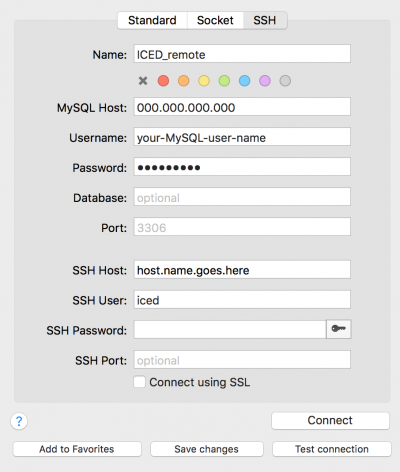meta data for this page
This is an old revision of the document!
Mac (or Linux)
The first thing is a MySQL client. I am using Sequel Pro (http://www.sequelpro.com) on my Mac. I suggest starting with this one. For Linux systems, I am not sure what to use…this may require some research.
Note: in the fairly near future it will probably be necessary to upgrade the database server from MySQL 5.7 to 8.something. Sequel Pro does not work with MySQL 8. Possible replacements are MySQL Workbench or the free version of TablePlus (http://tableplus.com). Also, there are lots of (hopefully better) options that are not free.
If you have a Mac or Linux machine, SSH is already installed (Mac) or most likely already installed (Linux), so you just have to generate the key pair.
If you are using a Mac (the procedure is basically the same on all Linuxes, although file locations may differ), open a terminal window and type the following at the prompt:
ssh-keygen
Hit return to accept the default file location. Then hit return again to store it without a passphrase (usually the only reason you would need a passphrase would be if you were using a shared computer). It will spit back some gibberish indicating that the key has been generated.
Now type the following:
cat ~/.ssh/id_rsa.pub
This will spit back a long code string with 'ssh-rsa' at the beginning and the name of your computer at the end. Copy the entire string, paste it into an email, and send it to Greg.
Now that we've dealt with SSH keys, open Sequel Pro to connect to the database. A window with connection details will open. Click the “+” icon at lower left to create a new named connection. Give it a sensible name (e.g., ICED_remote). Select the 'SSH' tab. The connection details should look like the following:
You will need to ask an administrator (= Greg) for (i) the correct IP address to enter in the 'MySQL Host“ field and (ii) the correct host name for the “SSH Host” field. The “Username” and “Password” fields are for your login on the ICE-D MySQL server. Again, talk to an administrator about getting this set up if you haven't already. The Databases field can be left empty. The “SSH User” field pertains to your username on the SSH gateway machine, which is “iced.” Leave “SSH password” blank – no SSH password is required because a key pair has been installed on your machine and the gateway server. Hit 'Save changes' to save the connection parameters for future use.
Now try either 'Connect' or 'Test connection' to see if it works.
